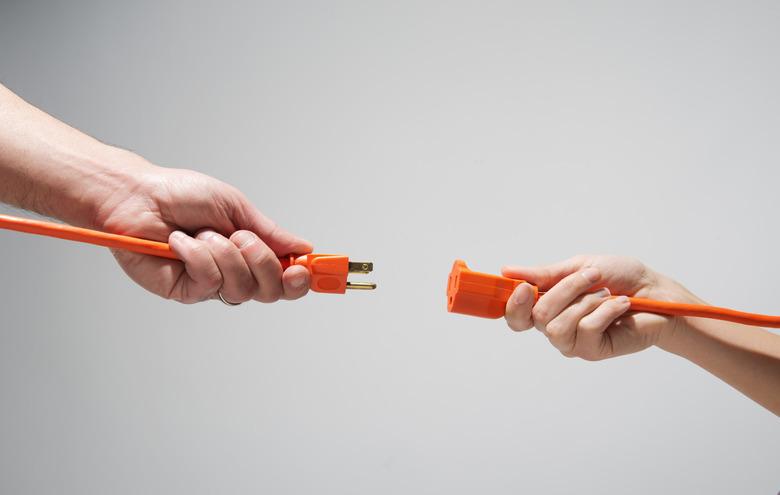How To Wire An Electrical Three-Prong Plug
A 120-volt electrical cord has three prongs when the cord includes a ground wire. The ground is a safety feature that ensures electricity has a direct path to earth in the event of loose connection. Before the National Electrical Code began requiring grounding in the mid-twentieth century, it was common to get a shock just by touching a switch or plug. Thankfully, those days are gone.
Not all 120-volt plugs have three prongs. Polarized plugs have only two, but the prongs have different widths, ensuring you can insert the plug into a polarized receptacle (which has matching unequal slots) in one direction. These plugs usually serve double-insulated appliances that don't require grounding. Heavy-duty extension cords and power cords, especially those designed for outdoors, all have three prongs. When you're replacing a three-prong plug or replacing an extension cord female end, you have to make sure you connect the ground, and that's easy to do.
Extension Cord Wire Colors
Extension Cord Wire Colors
When the time comes to replace a worn-out plug, you can simply cut it off. That exposes the three wires in the cord, and if you strip the insulation back and separate the wires, you'll see that they are all colored differently.
The color code is standard in electrical wiring. The black wire is the hot wire. It becomes energized as soon as you insert the plug into a working receptacle. The white wire is known as the neutral or return wire. Its function is to complete the circuit, and it becomes energized only when you activate a load by turning on a light or pressing the switch on a power tool. The third wire is the ground wire. In some cords it's bare, and in others it's covered with green insulation.
Wiring Procedure for a Three-Prong Plug
Wiring Procedure for a Three-Prong Plug
When you're replacing a three-prong plug, it's important to check the current rating for the cord and to purchase a plug that has the same rating. Using a plug with a higher rating is permissible, but it's overkill. However, using a plug with a lower rating is dangerous because the plug can overheat and melt if the cord carries the maximum amount of current it's designed to handle.
Once you've cut the old plug off the cord and stripped about 2 inches of sheathing from the cord, separate the wires and strip 1/2 inch of insulation from the end of each one. Separate the plug by pulling it apart or removing the screws holding it together and feed the cord through the base. You'll probably have to loosen the wire clamp on the base to get the cord through.
Loosen the terminal screws with a screwdriver, and then wrap the black wire clockwise around the brass screw and tighten the screw. Because you wrapped it clockwise, the screw will draw the wire onto the terminal when you tighten it. Attach the white wire to the chrome terminal screw and the ground wire to the green screw in the same way. Reassemble the two halves of the plug, tighten the clamp to hold the cord securely and you're done.
Can You Use Three-Prong Plugs in Two-Prong Outlets?
Can You Use Three-Prong Plugs in Two-Prong Outlets?
Many appliances, such as dishwashers, have three-prong cords because they need to be grounded for safety. If you only have two-prong outlets in your house, you can use a three-prong adapter, sometimes known as a cheater plug, to basically eliminate the third prong on the plug. The dishwasher may work, but it won't have ground protection unless you connect the grounding lug on the adapter to ground. Ask your great-grandparents what happens when appliances aren't grounded.
It's far safer to replace your outdated two-prong receptacles with three-prong ones. Installing a GFCI outlet in a receptacle circuit without a ground wire is a fast and effective way to get ground protection.
